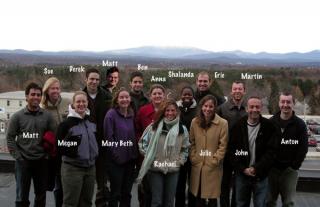|

Anatomy and Neurobiology Graduate Students
|
Department of Anatomy and Neurobiology University of Vermont CID Leadership Team Rae Nishi, Ph.D., Professor, Anatomy & Neurobiology, Graduate Program CoordinatorCynthia Forehand, Ph.D., Professor, Anatomy & Neurobiology, Graduate Program AdvisorRona Delay, Ph.D., Assistant Professor, BiologyJohn Green, Assistant. Professor, PsychologySue Buckingham, Graduate Student, Anatomy & NeurobiologySusan Hendricks, Postdoctoral Fellow, Anatomy & NeurobiologyMatthew Maneen, Graduate Student, Anatomy & NeurobiologyLiviu Muresan, Graduate Student, BiologyWenling Zhang, Graduate Student, BiologyContact: Dr. Rae Nishi, rae.nishi@uvm.edu, (802) 656-4504
Department Home Page
This is a link to the University URL for the Department of Anatomy and Neurobiology.
Graduate Program Home Page
This is a link to the URL for the new Neuroscience Graduate Program.
|
|
|
|
What do we want to accomplish in the CID? We
want to create a dialog between departments at the University of
Vermont who presently have a stake in Neuroscience Training so that we
can effectively design a new multidisciplinary graduate program in
Neuroscience.
|
|
|
More About Our Department The
Department of Anatomy and Neurobiology has long had a small graduate
program that emphasized research training in neurobiology while also
training students in gross anatomy, histology and neuroanatomy.
However, other graduate programs, particularly Biology and Psychology
have also trained students who completed dissertations in Neuroscience.
In 2002 we made the decision to expand the mentors available in the
Anatomy and Neurobiology Program in order to start the process of
creating a university-wide graduate program. At the same time, we
started meeting with other departments to plan a larger,
multidisciplinary program.
Exemplary Element Snapshot
Graduate Student Journal Club has been an exemplary feature of the
graduate program in the Dept of Anatomy and Neurobiology since 1987. It
is required of all students every year that they are enrolled. This
feature will be retained in the new Neuroscience Graduate Program.
|
|
|
|
What are we doing? Identify goals for training Stewards of the discipline of NeuroscienceCreate a graduate program that meets these goalsDesign courses that integrate teaching of didactic material with training in scientific survival skillsIntegrate clinical and basic science in training students
Innovations Snapshot
This innovation is a new course on Basic Science of Neurological Disease that we implemented in 2003.
|
|
|
Timeline Discussions
were initiated at UVM in 2002 regarding a new university-side graduate
neuroscience program. This was also when we applied for and was
accepted as an affiliate program of the CID. Our timeline was to get
this new graduate program approved by the time our participation in the
CID expired. The documents that we generated in the process of planning this program can be downloaded from the links below.
MOU 7-8-04
This is the first memorandum of understanding that was generated that
detailed what the program would be like and how resources to support
the program would be provided.
MOU 3-28-05
This MOU detailed how the program would be run and how it would be evaluated.
Grad Program Proposal
This
is the final document that we generated. It had to be approved by
Chairs, Deans, Curricula Committees, the Academic Senate, Dean of the
Graduate College, Provost, President, and Board of Trustees. On Feb 11,
2006 final approval was obtained (hooray).
|
|
|